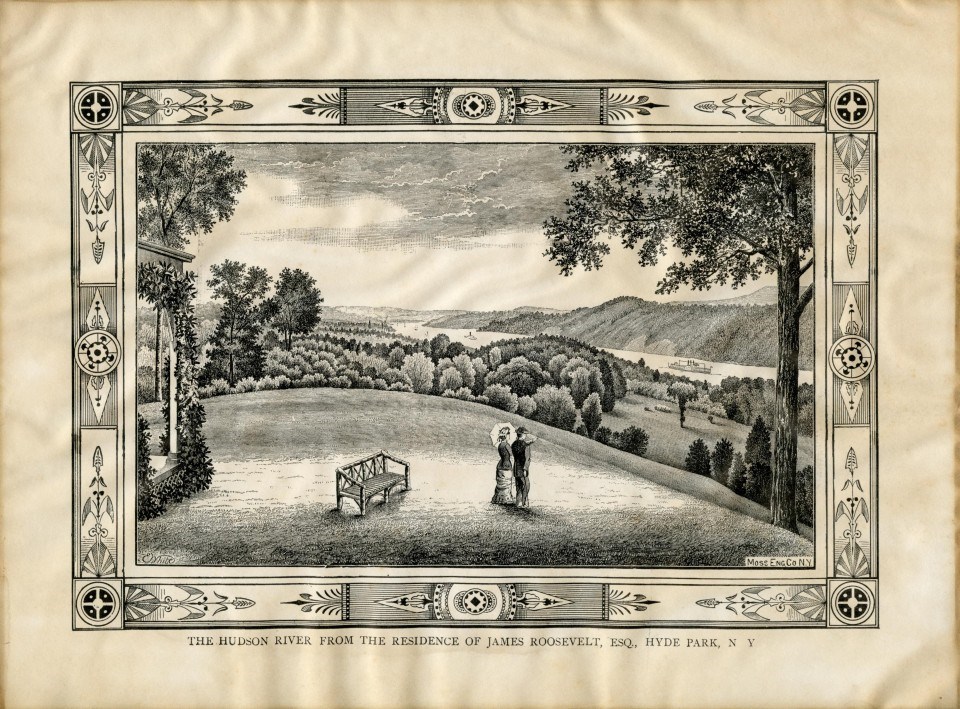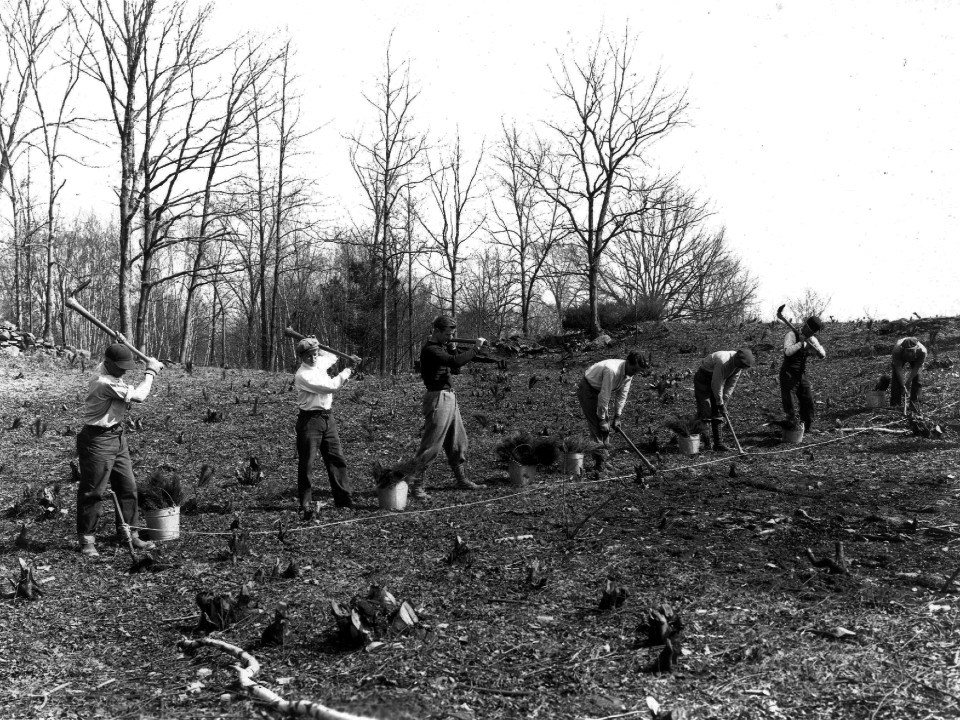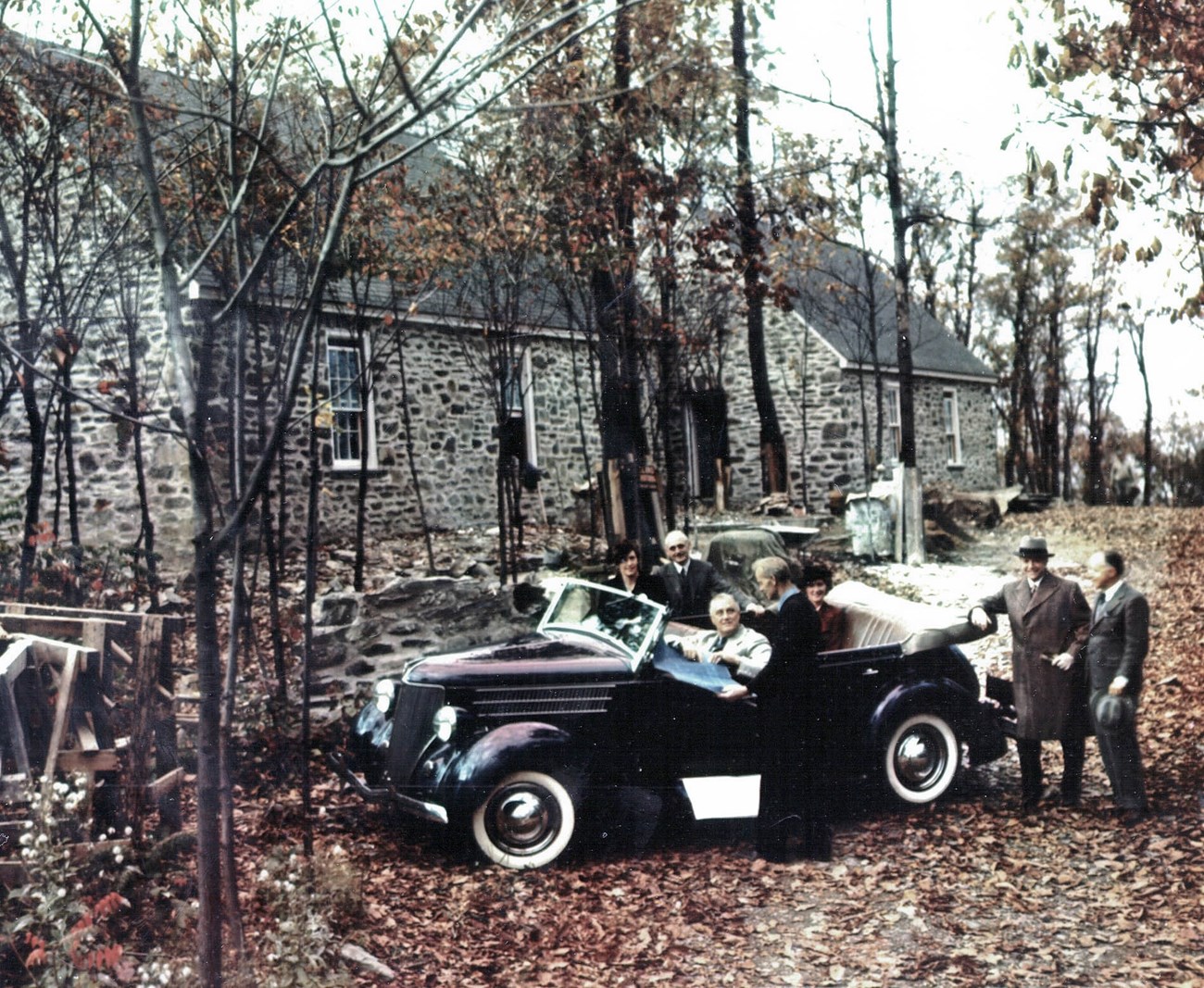Last updated: April 24, 2020
Article
A Land History of the Roosevelt Estate

NPS Photo
The Roosevelt Estate in the Town of Hyde Park is situated along the east bank of the Hudson River, approximately halfway between New York City and the state capital at Albany. At its height in 1939, the property extended for nearly two miles east to west, from the tidal banks of the Hudson River to Dutchess Hill at an elevation of 460 feet, the location of Franklin Roosevelt’s Top Cottage. Between 1939 and 1943, FDR subdivided two parcels from the estate, one containing his presidential library that opened in 1940, and the other containing the Springwood house and surrounding grounds, designated as a national historic site but not yet open to the public. After FDR’s death in April 1945, the remainder of the estate was subdivided and sold, with the last estate parcel sold out of the family in 1970.
The historic Roosevelt Estate is today comprised of a mix of private and public property. The National Park Service preserves 898 acres of the original 1,522-acre family estate in two park units—the Home of Franklin D. Roosevelt National Historic Site, established in 1944, and Eleanor Roosevelt National Historic Site (Val-Kill), established in 1977.
The Franklin D. Roosevelt Presidential Library and Museum is on a 16-acre tract that FDR subdivided from the estate. The property remains an integral part of the Roosevelt landscape, but is managed by the National Archives and Records Administration.

Courtesy New York Public Library
Before the Roosevelts, Pre-1867
Prior to European settlement of Hyde Park in the eighteenth century, the Roosevelt Estate was part of the homeland of the Wappinger Indians, who may have used the estate lands as hunting grounds and for agriculture. Following initial Dutch settlement in the Hudson Valley beginning in the seventeenth century, Europeans forced out the Native Americans and granted large tracts of land for settlement and speculation. The Roosevelt Estate was part of the Great Nine Partners Patent, issued to British land speculators in 1697. Two years later, the speculators subdivided the patent into long, rectangular parcels fronting on the Hudson River, known as water lots. Actual settlement on these lots within the Roosevelt Estate did not occur until ca. 1750, when the Crooke family built a house near the present Red House on the J. R. Roosevelt Place. Widow Everson built the second known house within the estate, the future Springwood house (FDR Home), on the Wheeler Place at some point between 1780 and 1793. The eastern parts of the water lots on the uplands above the Hudson River were settled later as farms in the late eighteenth and early nineteenth centuries.
On the eve of James Roosevelt’s purchase of the Wheeler Place in 1867, the western part of the water lots, adjoining the Hudson, had become country estates of wealthy New Yorkers, with the mansions on the west side of the Post Road and the estate farms on the east side of the road. The old Everson house was owned by Josiah and Mary Wheeler, whose father-in-law, James Boorman, owned the adjoining estate, Bellefield. Wheeler also owned the Bellefield farm on the east side of the Post Road. To the south, the old Crooke property, containing the Red House built in ca. 1833 and the estate farm on the east side of the road, had become the country estate of Sarah and François Robert Boreel. To the east of the river estates, the uplands remained independently owned by yeoman farmers.

FDR Library Photo
James Roosevelt's Springwood, 1867–1900
James Roosevelt (1828–1900) purchased the portion of the Wheeler Place west of the Post Road in 1867, following a fire at the family’s prior country home, Mount Hope, located about a mile to the south. James and his first wife, Rebecca Howland Roosevelt (1831–1876), had a son, James Roosevelt Roosevelt (1854–1927), known as Rosy. The family moved into the Italianate Wheeler-Everson house, and renamed the estate Springwood. The following year, James Roosevelt purchased the adjoining Boreel Place including the house and farm, and three years later, in 1871, purchased the Bellefield farm on the east side of the Post Road from Timothy Bracken. Roosevelt maintained the Boreel farmhouse and barns, but removed the Bellefield farm buildings. He made few other changes to the Introduction estate, aside from addition of a boathouse, road to the river, staff quarters, and new stables near the Springwood house. In 1878, Rosy moved into the Red House on the Boreel Place with his wife, Helen.
Two years after Rebecca’s death in 1878, James was remarried to Sara Delano Roosevelt (1854–1941). Two years later, Franklin Delano Roosevelt (1882–1945) was born at Springwood. Over the course of the next two decades, James Roosevelt made few additional changes to the family estate, except for the acquisition of the Kirchner Place, a largely undeveloped tract south of the Boreel Place, in 1886. This property brought the total extent of the Roosevelt Estate to 624 acres.
Upon James Roosevelt’s death in 1900, he left the Wheeler Place and Home Farm to FDR, subject to the life estate of Sara, and the west half of the Boreel Place and the Kirchner Place to J. R. Roosevelt. His will stipulated the right to maintain the river view from the Springwood house across the Boreel and Kirchner Places.

FDR Library Photo
Estate Improvements and Amateur Forestry, 1900-1928
At the time of his father’s death, FDR was in his first year at Harvard, from where he graduated in 1904. The following year, he married Eleanor Roosevelt (1884– 1962), and together they had six children: Anna (1906–1975), James (1907–1991), Franklin Jr. (1909–1909), Elliott (1910–1990), Franklin Jr. (1914–1988), and John (1916–1981). The family made the Springwood house, which they shared with Sara Roosevelt, their home.
In 1905, FDR began planning improvements to the Springwood estate, which included additions to the house, gardens, and farm, and a forestry program. However, it was not until 1911, when FDR entered the state senate and was appointed to the state Forest, Fish and Game Commission (precursor to the Conservation Department), that he began these improvements in earnest. That year, he developed a forest management plan, and purchased his own property, the 194-acre Bennett Farm, which he would rent to tenant farmers and use for forestry purposes. The next year, he set out his first forest plantations on old fields and gravel lots on the Wheeler Place, using tree stock ordered from the state nurseries that was planted by estate staff. By 1928, FDR had set out approximately sixteen plantations on the Wheeler Place, Home Farm, and Bennett Farm, totaling more than 42,000 trees.
Other improvements that FDR made to the estate during this period, working closely with his mother, included redesign of the Springwood gardens in ca. 1912, construction of a modern dairy building at the Home Farm in ca. 1915, and expansion of the Italianate Springwood house into a Colonial Revival–style mansion in 1915–16. Rosy undertook similar improvements to his place, including expansion of the Red House and redesign of the gardens around 1915. He also built a teardrop-shaped trotting course on the Kirchner Place.
In 1925, four years after contracting polio which left him without use of his legs, FDR purchased his second upland farm, the 192-acre Tompkins Farm. The property consisted of abandoned fields well suited to reforestation, and a farmhouse and barn at the corner of Violet Avenue and Creek Road. Around this same time, Eleanor Roosevelt and her friends Marion Dickerman and Nancy Cook built a retreat named Val-Kill at a favorite picnic spot along the banks of the Fall Kill at the east end of the Bennett Farm. With FDR’s support, the women built a swimming pool and Dutch Colonial–style house, known as Stone Cottage, that was completed in 1926. The women also developed Val-Kill into an experiment in rural industry, focusing initially on Nancy Cook’s expertise in furniture making. While construction of Stone Cottage was underway, a second building was constructed to house the furniture shops of Val-Kill Industries.

FDR Library Photo
Public Life and Professional Forest Management, 1928-1945
FDR was elected as governor of New York State in 1928, and by the fall of the following year he was planning on expanding his forestry operation at Hyde Park with the help of the New York State College of Forestry at Syracuse University. He worked with forestry professor Nelson C. Brown to establish demonstration and experimental plantations on the Tompkins Farm along Creek Road and Violet Avenue. Between 1930 and 1933, the College of Forestry set out thirty-six plantations containing approximately 88,600 trees. After 1933, FDR continued to rely on professional assistance from the college’s forestry faculty, particularly Nelson Brown, who served as his unofficial and unpaid forest manager for the next twelve years. During this time, Brown helped FDR expand his forestry program, begin large-scale Christmas tree production, and acquire additional land for reforestation to the north and east of the Bennett Farm. These acquisitions included the 186-acre Dumphy Farm, adjoining the Bennett Farm, in 1935 and 1937; the 90-acre Hughson Farm, to the north of the Dumphy Farm, in 1937; and the 133-acre Rohan Farm, east of the Bennett Farm, in 1937. FDR also purchased several smaller properties between 1935 and 1938, including the Briggs and Lent Wood Lots, and portions of the Wright and Jones farms. These acquisitions increased the total extent of the Roosevelt family estate to 1,521 acres. FDR developed a network of woods roads to access his plantations and the far corners of his property.
FDR’s election as president in 1932 resulted in several changes to the estate over his four terms in office. In ca. 1933, the U.S. Secret Service erected a small building in the Springwood Home Garden. Following U.S. entry into World War II in December 1941, the Army implemented an extensive security system across the estate to protect FDR while he was at home. This system included crash barriers, jeep roads, telephone lines, guard shacks, and electric security eyes.
FDR’s other improvements to the estate during this period included construction of his own retreat, Top Cottage, in 1938–39. The Dutch Colonial–style house was located on the summit of Dutchess Hill east of Val-Kill, a site that straddled the boundary of the Dumphy Farm and Briggs and Lent Wood Lots. FDR’s other major addition to the estate was his presidential library, which was built in 1939–40 on the North Avenue Lot field near the Springwood house and gardens. FDR gave the 16-acre library property to the federal government based on a joint resolution passed by Congress in 1939 that also allowed the government to receive, through donation, any part of the Roosevelt Estate. This legislation enabled FDR to give the Springwood house and surrounding 33 acres of the Wheeler Place to the federal government in December 1943, subject to the life estate of the Roosevelt family. In 1944, the National Park Service designated the property the Franklin D. Roosevelt National Historic Site.
Subdivision and Development, 1945-1970
Following FDR’s death in 1945, the trustees of his legal estate executed his will by selling off all of the Roosevelt Estate land to maximize financial returns. The National Park Service, limited by legislation to acquiring estate lands only through donation, could not acquire property from the trustees. The sell-off included all of the estate except for the federally owned library and national historic site, and the J. R. Roosevelt Place. FDR had inherited the Boreel Place tract from J. R. Roosevelt, but the trustees could not sell the property because FDR’s niece, Helen Roosevelt Robinson, held a right to life estate. Helen also owned the adjoining Kirchner Place.
The trustees sold two parcels west of the Post Road, surrounding the national historic site, by 1952. These included the Rogers Land, which was sold to Mary Newbold Morgan, and the lower part of the Wheeler Place, which was sold to the Franklin D. Roosevelt Foundation. The foundation then gave the property to the National Park Service. Helen Roosevelt continued to reside at the J. R. Roosevelt Place until her death in 1962. The trustees then acquired the Kirchner Place from Helen’s estate, assumed ownership of the Boreel Place, and sold the combined parcel to developers who built the Hyde Park Mall there in ca. 1970.
The estate property east of the Post Road, encompassing the Home Farm and uplands farms including Val-Kill and Top Cottage, was acquired by Elliott Roosevelt in 1947–48. The trustees sold the Post Road frontage of the Home Farm to a corporation formed by Elliott, the Val-Kill Company. He subsequently leased and sold this property to developers, who erected commercial and residential development between 1948 and 1952 that included a drive-in theater, a gas station, a gift shop, a Howard Johnson’s restaurant, an indoor movie theater, apartments, and single-family houses. On the property east of the Post Road frontage, Elliott, with the support of Eleanor Roosevelt, planned a large agricultural operation known as Val-Kill Farms. He attempted to keep FDR’s forestry program going, and expanded livestock operations at the Bennett and Rohan Farms. Elliott moved into Top Cottage, and Eleanor made the Val-Kill furniture factory her home.
Val-Kill Farms failed by 1951, and Elliott subsequently subdivided and sold off all of the property to developers, except for a 180-acre tract on the Bennett and Tompkins Farms that included Val-Kill. In 1952, John Roosevelt acquired the Val-Kill property from Elliott, and continued to own it following Eleanor’s death in 1962. In 1970, John sold the Val-Kill property to developers. Hundreds of houses were built on the Dumphy, Hughson, and Rohan Farms beginning in 1952. The land west of Violet Avenue, including parts of the Home Farm, Bennett Farm, and Tompkins Farm, was also acquired by a developer but never subdivided.
Epilogue, Post-1970
After the sale of the last Roosevelt estate parcel in 1970, there was increasing interest among the public and the Park Service in preserving the estate lands from development. No new major residential subdivisions were planned, but the developments begun prior to 1970 were completed, including the subdivisions on the Dumphy and Hughson Farms that were built-out by 1980, and the subdivisions on the Rohan Farm, completed during the 1980s. There was also new development along the Post Road, including a senior housing complex and strip shopping plaza at the Home Farm and a supermarket to the south of the estate.
In 1975, the Hyde Park Visual Environment Committee was formed to preserve the 180-acre Val-Kill property, which was slated for a retirement community, nursing home, and single-family homes. In 1977, the Congress passed legislation establishing Eleanor Roosevelt National Historic Site with funding for land acquisition and site development, and seven years later following extensive restoration and rehabilitation, the site opened to the public.
At the Home of Franklin D. Roosevelt National Historic Site, the National Park Service continued to acquire remaining undeveloped estate lands, recognizing their historic significance in interpreting FDR’s interests and achievements, and preserving what remained of the rural setting of the site. In 1974, the park acquired the Rogers Land that FDR had purchased in 1935, and in the following year acquired Bellefield, which was not historically part of the Roosevelt Estate, to protect the setting of the national historic site and provide space for administrative functions. Between 1984 and 1989, the park acquired 29 acres surrounding the Red House to preserve the front field that was in the immediate setting of the FDR Home.
In 1998, Congress passed legislation that allowed the Park Service to acquire by purchase or donation any lands within the historic limits of the family estate (the original 1939 legislation allowed for acquisition through donation only). Through this legislation, the park acquired Top Cottage and surrounding 40 acres in 2002; 35 acres of the Kirchner Place the same year; and 335 acres comprising most of the undeveloped estate land between the Post Road and Violet Avenue in 2007. This purchase allowed the park to finally reconnect Val-Kill and Top Cottage with Springwood. In 2010, the park acquired 20 acres of undeveloped land along the Post Road that had been part of the former Home Farm.
These property acquisitions over the past four decades have reestablished a large part of the Roosevelt Estate, although the historic rural character along the Post Road remains obscured by suburban development. Together with the acquisitions, the park has made a number of changes to enhance historic character, recreation, and park operations, including extension of trails, removal of a 1947 parking lot from the Home Garden, and construction of a new visitor center at Bellefield. The park is also planning to reestablish the river view from the Springwood house that was lost after 1945, and is developing a forest management plan that will perpetuate FDR’s conservation legacy at Hyde Park.
